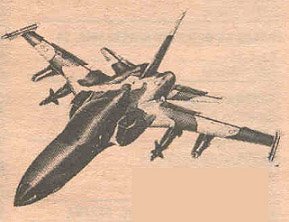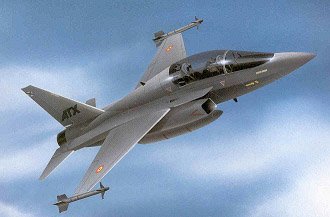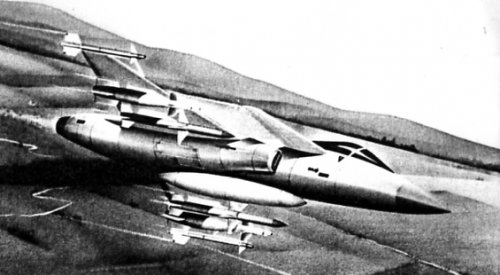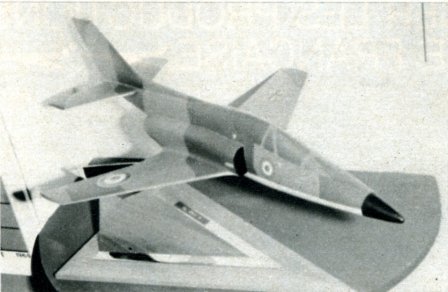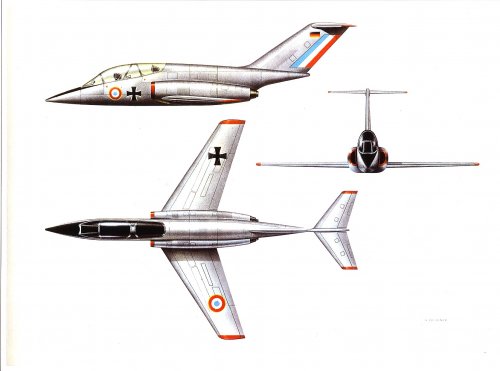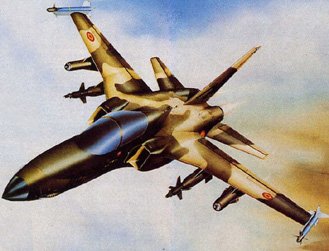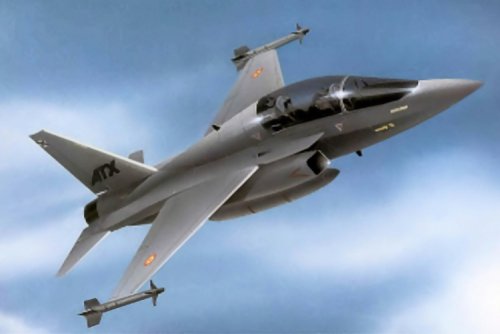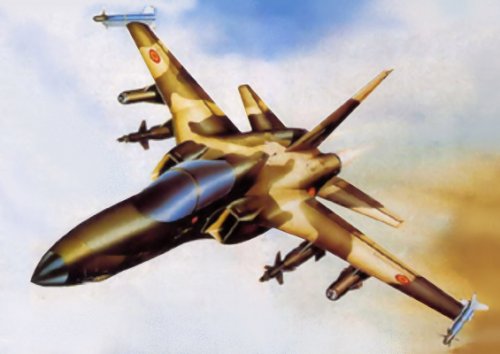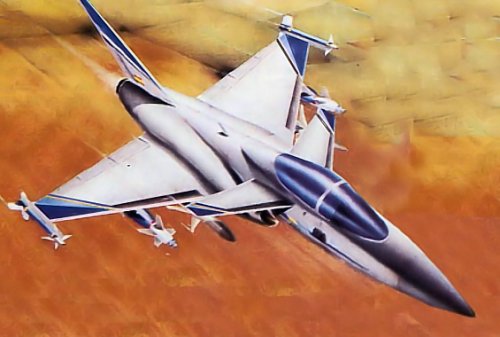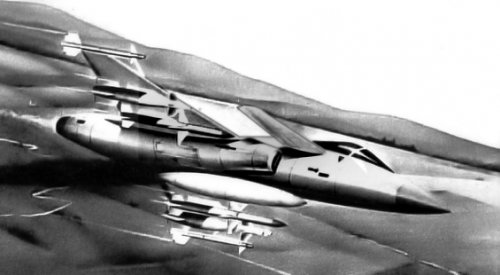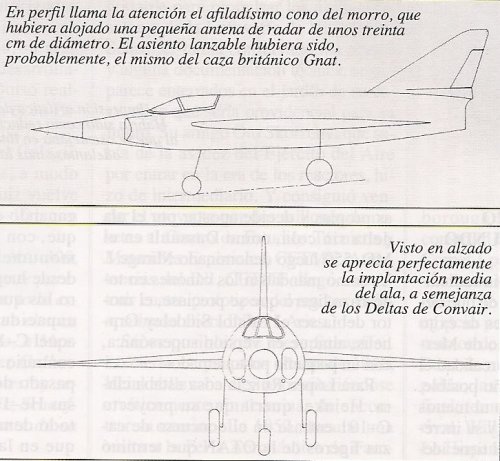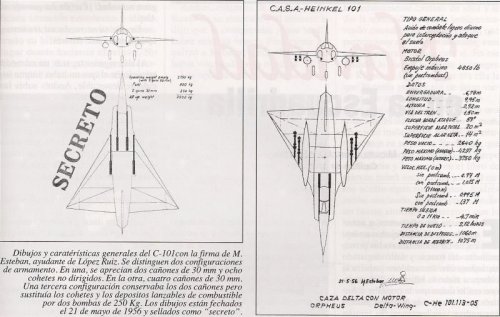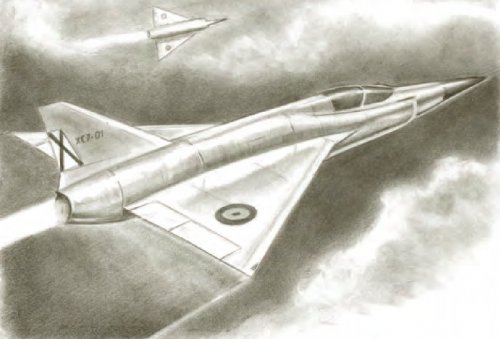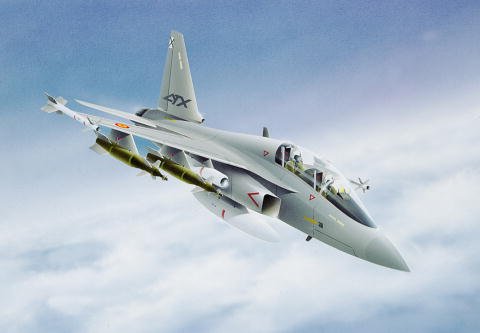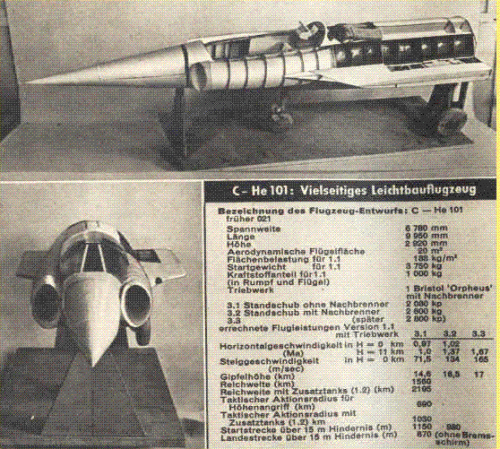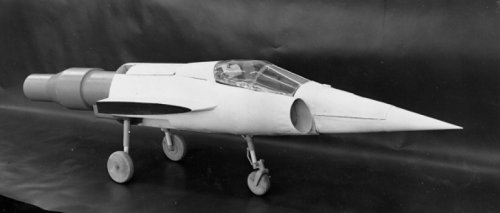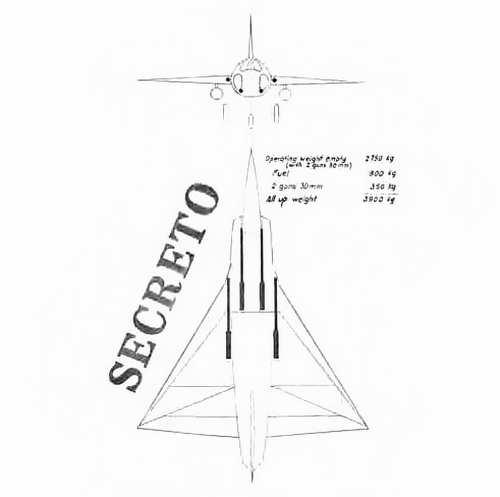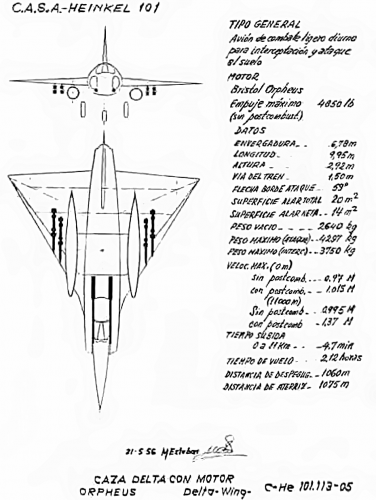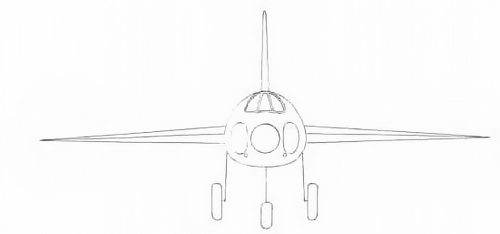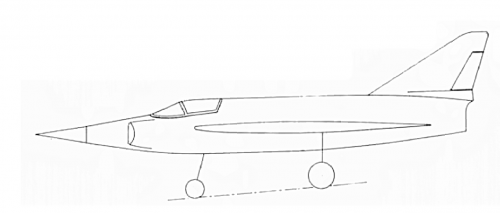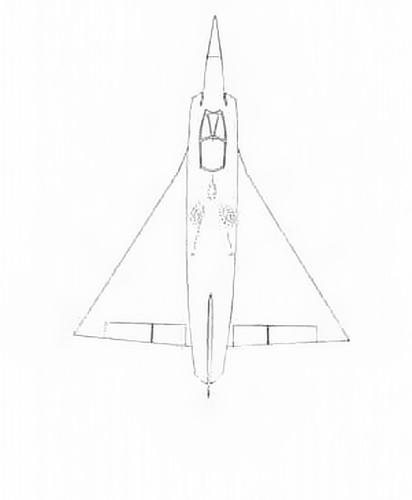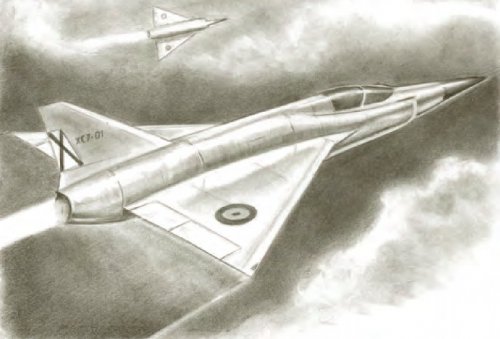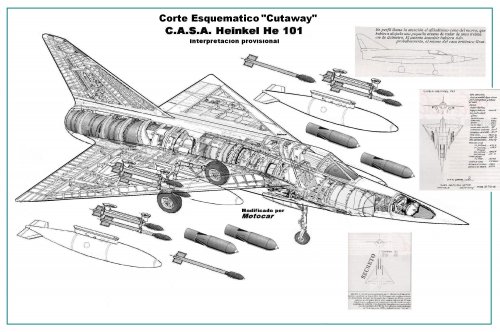Poor Google transation of this article from Revista de AERONAUTICA Y ASTRONÁUTICA December 2009. Added a couple of pics from Heinkel topic.
http://www.ejercitodelaire.mde.es/stweb/ea/ficheros/pdf/7A1A78A19DD01283C125767F0038BBE9.pdf
The Secret History of the first C-101
SAN CARLOS PÉREZ EMETERIO
PERHAPS WAS THE LEAST KNOWN OF FIGHTERS PROJECTED BY HEINKEL. SECRET PAPER STARTED, ENDED IN WET PAPER. EXISTENCE OF YOUR DATA JUST A FEW WERE SOME MARKS THAN HALF A CENTURY ASLEEP IN THE COLLEGE OF AERONAUTICAL ENGINEERS. NOT LONG AGO, JOSE LOPEZ RUIZ EXTRACTED FOR US FROM THE DRAWER OF HISTORY. WHO WAS THE BETTER KNOW THE CASA-HEINKEL C-101 PROJECT. HIM, AND HIS MEMORY, VA DEDICATED THIS ARTICLE.
Always said Ernst Heinkel had come, or at least had "passed through" through Spain in 1956. its hypothetical visit to the CASA factory at Tablada, if true, no photo or document that accredits was preserved; Too bad, would have been quaint see walking among old Heinkel He-111 with Rolls Royce Merlin engined while not far away, in the district of Triana, his great rival Willy Messerschmitt developing a supersonic fighter. Heinkel Do you really wanted to compete with him in Spain?
Who brings what and why?
In a small room of the College of Aeronautical Engineering, as a receiver, José López Ruiz looks back at the drawings of C-101 with nostalgia. I liked more than the HA-300, I do not know, I see more beautiful, do not you think?
But hey, who cares, this was impossible, as the fighter Meserschmitt. By the way, brought him González Gallarza Messerschmitt, Heinkel and ... look, I'm quite sure that it brought Fritz Schaeffer, who had been part of their team in Germany.
Very plausible hypothesis. Schaeffer, one of the greatest geniuses in the German jet engine project, had appeared in 1951 in Madrid. He carried under his arm the planes of his masterpiece, the S-011 I 1300 kilos of thrust. Intended to succeed the Jumo-004 in 1946, the S-011 I came late to propel the last reactors Hitler's Luftwaffe, but Schaeffer had retained some technical drawings and documentation; apparently buried in the garden of his home. Something that would be lucky for your future. His friend Oto Skorzeny, who knew the greed of the Air Force to enter the jet age, brokered. And he managed to sell the project for two million pesetas Technical Studies Center and Special Materials, CETME. At the request of INI, CETME, came to build four prototypes of the reactor, now renamed INI-11 Aries. yes; Schaeffer may be.
The truth is that, to the heights of 1956, Heinkel was ten years older unfinished moving erratically to find their way. In 1952, during a visit to the Farnborough Airshow hinted that licensed from de Havilland Comet I for the new Lufthansa. Obviously without any response. Then he was invited by the Egyptian government to design and build a jet fighter with great potential.
But again, luck turned her back; authorities of Cairo, in the end, ended up in the arms of his great rival, Willy Messerschmitt, through La Hispano Aviación.
SMALLEST SUPERSONIC FIGHTER IN THE WORLD
Heinkel then radically changes his mind. It convinces you have a much better chance of success if it comes to playing on the field and get Messerschmitt fighter realizing the smallest possible reaction. Maybe you feel attracted, or at least influenced, by Petter English and incredible Gnat light fighter. But he has ideas and decides to bet on the delta wing tailless, as the Dassault MD-550 later called Mirage I. And, as charges sent around light fighter worth his salt, the engine should be the Bristol Siddeley Orpheus, although supersonic version, with a little afterburner. For López Ruíz things were clear. Heinkel wanted his C-101 project entered in the competition for light NATO fighters who ended up winning the Italian Fiat G-91. Something that in retrospect was a monumental chimera. NATO, of course, wanted light fighters, but wanted ground attack air-to-air high capacity, and one C-101 hang gliding was just the opposite. And not to mention it's past and the memory of Heinkel I-111 bombarded their London; all too recent for NATO is accepted just like that; being much less Spain through.
Still, in the spring of 1956 Heinkel visit Madrid with planosdel stored in an elegant portfolio lightweight fighter. The government, of course, is aware. Since he is Aeronautical Constructions completed with a lunch at restaurant Club 31, Alcala Street. Your host is D. Pedro Huarte Mendicoa, Director, Office of Project HOME and the food will accompany Fritz Schaeffer, Jose Lopez Ruiz and Ricardo Valle. That's when Lopez Ruiz is captivated through Heinkel. I remember perfectly.
I saw the plans on the table. All annotated in German. Four leaves Heinkel bringing in the wallet ... nothing. Huarte told me with great mystery: this is top secret. Heinkel, meanwhile, explained what could be one tiny game. By then, none of those great German engineers, Heinkel, Messerschmitt Kurt Tank, Horten (perhaps Lippisch was the exception) had planned to fly anything over Mach 1, but I think they had exchanged information with each other; yes, I am convinced. Now, I insist, Heinkel captivated us all. I knew what he said had a clever face ... something terrible ... After lunch, Huarte Mendicoa secretly called for López Ruiz and instructed to get down to work. -A See López Ruiz, you having cooler I calculate the polar, check me if figures giving Heinkel performances are real. Not that Lopez Ruiz for his youth had "cooler" calculating polar; is that it was a brilliant engineer who, at least in mathematics, pulled several lengths ahead of his Project Manager, the legendary Don Pedro. He was only twenty-six and had just arrived home after a stint as an intern at INTA. Check Heinkel calculations would take well into 1957 Le seemed accurate, but not what he was seeing the extreme complexity of the wing structure. It was a half-delta implementation, consisting of two semialas perfectly removable, who joined the wing spar. The anchor was a real puzzle. The drawings came and went constantly from your table of Ricardo Valle, another young engineer who also put fault the Wing: I do not understand this structure based Heinkel stringers, 'he said this will be too complex to build, I prefer frames ...
Valle blunted in the calculation of structures, but his greatest fortune was to have his side to the very Polman Herman, the designer of Junkers Ju-87 Stuka. For those of fate, Polman, who left Germany in 1945 to escape the allies could reach Spain from the hand, too, Otto Skorzeny. They had found shelter in the Project Office and heights HOUSE 1956 had already left an imprint happy working on the C-207 Azor. And thanks to the salary of Casa had rented a little cottage in Canillejas. A day came and went from the Office in Metro Project HOME, along Princess Street to Sales; and on the tram from there to Canillejas. At sixty years old, seemed a happy and caring man; particularly López Ruiz, who through the age difference, it was like a son. On the Wing C-101 does not seem to rule. But surely remember the old days; when, in 1935, Willy Messerschmitt won the game and got a Heinkel the Me-109, with a simpler wing, be imposed on the He-112. Something, however, did not matter after twenty years. Polmann knew full well that the Spanish industry was not prepared to supersonic fighters, let alone to develop jet engines. INI-11 Aries, in fact, abandoned in late 1956, but not before Mendicoa Huarte, asked us:
Tell me, López Ruiz, if got give more thrust to Aries, do you would install on the C-101, instead of Orpheus?
Completely impossible to exhaustively questioned replied the.
KEEP IT IN A DRAWER
Nevertheless, the Ministry and stamped the C-101 gave the official blessing denominándole C-7, behind, both HA-300, which was C-6 and obviously the Sabre, which was C-5. In practice that was it, as with the first months of 1957, the project began to crumble on contact with reality. On one hand, the prototypes (*) for the contest NATO were already flying and about to start fas ede evaluation. In this sense, Heinkel and he would have convinced his C-101 had nothing to do. Furthermore, the Air Force already had the F-86 and viewed with considerable skepticism the development of HA-300 The Hispano Aviacion. If the country was not going to pay that chimeric HA-300, do compete with other equally impossible, and something was insane; more so if you think that the draft Heinkel was not yet fully developed; and that its very existence was against this rule in postwar whereby bombers and transport aircraft CASA and corresponded to the fighters and coaches to the Hispano Aviación.
The inevitable outcome reached by the spring of 1957 One morning Don Pedro Huarte Mendicoa rewound the C-101 planes and went boldly to the Air Ministry. I received the Minister, Rodriguez and Diaz de Lecea. He was there all morning. When he returned to the project office came pale, like someone just got a jug of ice water. He immediately called Lopez Ruiz and vehement tone between confidential and said:
-A See López Ruiz, these planes and all that the C-101 thong ... everything., Huh ..? store it in a drawer. And that's it. Without further.
Then topped with some vehemence:
it does not talk about this again. Not without some perplexity, López Ruiz complied. And in a few minutes the C-101 passed the secret to oblivion. Moreover, in the same drawer he found a project that he had begun, in which, following the rule of the area, gave way to bottle Coca Cola fuselage drawn by Heinkel. But this time it was more dramatic, and, as was his, broke directly without asking.
POSTSCRIPT
Hienkel Ernst died on January 30, 1958, just turned seventy. Even two months ago not a photographer captured her image toasting with champagne with his great rival, Willy Messerschmitt. Both smiled resignedly. A symbol. History, and NATO, are now assigned the role of making licensed the Fouga Magister. They, the parents of the first jet fighters ...
Meanwhile, Herman Polman return to Germany to direct the destinies of the Hamburger Flugzeugbau HFB. There, in 1959, he was reunited again with his young friend López Ruiz, who visited him to discuss the C-209, a version of Azor pressurized Napier Eland turboprop. Obviously, the project came late and without a future, but in the end, all things considered, that was not important, because thanks to two big engineers that utopia, a veteran and a very young, to be returned, this time in a cold and severe HFB building.
And now tell me, López Ruiz, how is Madrid? And my neighborhood Canillejas ...?
(*) The participants in the Contest NATO prototypes were on the French side, the Breguet Taon the SNCASO Baroudeur and Dassault Etendard versions II, IV and VI. On the Italian side the Fiat G-91, which eventually turned out winner.
C101.jpg
Artist's impression of the C-101 in clean configuration. It would be like halving the Convair F-102, which it resembled in general, but more Heinkel adelantase position air intakes.
C101a.jpg
This drawing of the C-101 plan suggests the landing gear retraction, influenced by the minimum dimensions of hunting. The two main legs retract forward; the nose back.
C101b.jpg
In Profile striking razor-sharp nose cone, which had housed a small radar antenna about thirty inches in diameter. The ejection seat had been, probably, the same as the British fighter Gnat.
C101c.jpg
Seen perfectly flat appreciates the average wing establishment, like the Convair Deltas.
C101d.jpg, C101e.jpg
Drawings and General Characteristics of C-101 with the signature of M. Esteban, assistant López Ruiz. Two configurations differ arms. In one, two 30mm cannons eight unguided rockets are appreciated. In the other four 30mm cannons. A third set but kept both barrels replaced launchable rockets and fuel tanks for two bombs of 250 Kg. Drawings are dated May 21, 1956 and stamped "secret".

